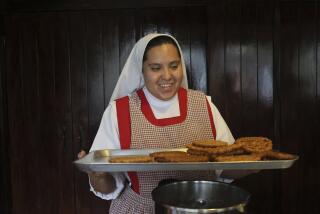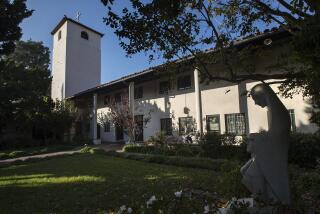Ranch Turned Abbey Is Fertile Field for Serenity
- Share via
Hidden from the hubbub of traffic and commerce, St. Andrew’s Abbey sits on 1,900 verdant acres of cottonwoods, sycamores, pines and apple orchards in the Antelope Valley.
Benedictine monks have sought “silence and wilderness” there for more than 50 years. The sign above the entrance reads, “No Hunting -- Except for Peace.”
Named for the motherhouse in Belgium and dedicated on St. Andrew’s feast day, Nov. 30, 1955, this former turkey ranch is home to two dozen monks in flowing robes. Anyone who seeks a few days of contemplative solitude also finds refuge there.
The abbey was founded by Father Vincent Martin, a Belgian-born monk and priest who parlayed a $50,000 gift from the mother-abbey into this popular self-supporting institution, 75 miles north of downtown Los Angeles in the high desert of Valyermo.
Martin, a missionary in China before World War II, was imprisoned in a Japanese prisoner-of-war camp.
Later, he earned advanced degrees from Harvard, studied in Jerusalem and learned at least six languages, including Hebrew.
His black leather address book, now in the abbey archives, includes the names of renowned people he encountered around Southern California: actress Jane Wyatt; Bob and Dolores Hope; Zubin Mehta, former conductor of the Los Angeles Philharmonic.
Martin’s world extended far beyond the monastery walls. “I speak in English, think in French, move in Jewish circles and dream in Chinese,” he once said.
“He was a humble man, a doer and a go-getter,” Abbot Francis Benedict, who runs the monastery, said in a recent interview. “He was inquisitive, very bright, always reading, but especially debonair. He always kissed women’s hands, which melted their hearts.”
In a 1993 Times interview, Martin described the collection of ranch buildings and newer structures as an “island of sanity” that attracted people “like they were coming for clear water.”
Martin established the monastery with nine Benedictine monks who had been expelled from communist China. Two are still alive: Fathers Eleutherius Winance, 97, and Werner de Morchoven, 92.
The monks converted a barn into their living quarters. They enlisted the help of volunteers to lay the floor and lug a slab of granite for the altar to the stable, which became the chapel.
The hilltop ranch house was turned into guest housing. The ranch foreman’s house became the gift shop.
Once the monastery became livable, the monks had to find a way to pay for food. They began by hosting a country fair at which they sold ranch-grown fruits and vegetables. Over the years, it grew into a fall festival with arts and crafts, entertainment and lots of food.
Today, much of the abbey’s funds come from the sale of ceramic plaques crafted in a workshop beside the cloister.
The artworks take the shape of angels or saints related to occupations and avocations: a fishing angel, for instance, or a fireman angel.
The plaques are designed and crafted by Maur Van Dooerslaer, a priest who lives in Belgium half the year and at St. Andrew’s the other half. The items are sold in the gift shop, by mail order and at the abbey’s annual festival.
Among the monks at the abbey, Martin is remembered as someone who knew wealth as well as poverty.
In 1928, at age 16, he joined the Benedictines at the Abbey of St. Andrew in Brugge, Belgium, which was a leader in the missionary movement. Two years later, he became a monk.
In 1936, he was ordained a priest. His father celebrated by digging up “a barrel of wine he had buried in his garden during World War I,” Benedict said.
The Benedictines wanted to open a monastery in China; Martin wanted to go. He had been in China only a year in 1938 when the Japanese invaded.
Martin hunkered down in caves with 500 Chinese Christian soldiers, whom he served as chaplain. He and a small group of the soldiers were captured by the Japanese in 1941. He was tried as a spy, found guilty and sentenced to death.
In 1998, in an interview with the Antelope Valley Press, Martin described the ordeal. “The trial was three days -- Monday, Tuesday, Wednesday. They told me I would be shot on Thursday.” But for reasons he never learned, Martin was re-tried and sentenced instead to the POW camp.
To stave off boredom, he learned English and Russian from fellow prisoners. He recuperated from beriberi and other illnesses in a Beijing hospital where his captors had sent him.
There, his “confinement” was relative. Every Tuesday afternoon, he was permitted to visit Father Pierre Teilhard de Chardin, the renowned French Jesuit. The paleontologist and philosopher spent long hours discussing with Martin the spiritual and physical evolution of man.
With the war’s end, Martin took up new duties as a Chinese liaison with the Marines. He was ushering 2,000 Japanese officers and soldiers back to Japan from China, all of them suffering from tuberculosis, when he too contracted the disease. In 1947, after months of rest, he headed to America and enrolled at Harvard.
In 1955, his Belgian order decided to open a monastery in the United States and assigned Martin to do the legwork. He examined more than 200 properties before finding the rustic, secluded Hidden Springs Ranch, at an elevation of 3,600 feet and with a natural duck pond.
“Searching for property, he disguised himself in a suit, calling himself ‘Mr. Martin’ because of anti-Catholic prejudices,” Benedict said. At the time, the abbot said, some people refused to sell to Catholics or would hike the price.
By 1972, the group was strong enough in numbers and finances to be elevated to an abbey, but it chose to remain a priory.
“Abbeys in Europe are grand places, with hundreds of monks and huge libraries,” Benedict said. “We didn’t have visions of grandeur.”
But two decades later, the monks decided that its permanent status called for recognition as an abbey. Benedict, now 58, was elected abbot.
Benedictines pride themselves on resilience. When St. Benedict’s Italian hilltop fortress, Monte Cassino, was destroyed several times over the centuries, it was rebuilt each time. After World War II, its rebuilding took 10 years. The abbey’s motto: “Struck down, it will live again.”
Martin died of a heart attack in 1999, at age 87. He is buried in the monastic cemetery on the hill overlooking the abbey and grounds. A simple concrete cross, embedded with rock, marks his grave -- like the gravesites of others who preceded him in death.
His motto isn’t engraved on his humble headstone, but it remains in the monks’ hearts:
“To respect old age and to accept joyfully to fade away.”
The Benedictine monks of St. Andrew’s Abbey will hold their 49th annual fall festival from 9 a.m. to 6 p.m. Sept. 23 and 24 at the monastery’s ranch, 31001 N. Valyermo Road, Valyermo.
More to Read
Sign up for Essential California
The most important California stories and recommendations in your inbox every morning.
You may occasionally receive promotional content from the Los Angeles Times.













